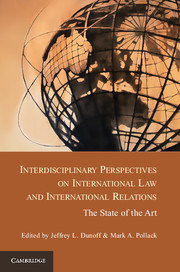 Interdisciplinary Perspectives on International Law and International Relations
Interdisciplinary Perspectives on International Law and International Relations Book contents
- Frontmatter
- Contents
- Contributors
- Acknowledgments
- Part I Introduction: Setting the Stage
- 1 International Law and International Relations
- 2 Law, Legalization, and Politics
- Part II Theorizing International Law
- Part III Making International Law
- Part IV The Interpretation and Application of International Law
- Part V Enforcement, Compliance, and Effectiveness
- Conclusions
- Index
- References
2 - Law, Legalization, and Politics
An Agenda for the Next Generation of IL/IR Scholars
Published online by Cambridge University Press: 05 January 2013
- Frontmatter
- Contents
- Contributors
- Acknowledgments
- Part I Introduction: Setting the Stage
- 1 International Law and International Relations
- 2 Law, Legalization, and Politics
- Part II Theorizing International Law
- Part III Making International Law
- Part IV The Interpretation and Application of International Law
- Part V Enforcement, Compliance, and Effectiveness
- Conclusions
- Index
- References
Summary
Framing the Agenda
The intersection of international law and international relations (IL/IR) has developed into a sophisticated intellectual enterprise, as the papers in this volume attest. Although IL/IR continues to make important contributions to both disciplines, however, there remains room for further advances, in part by rebalancing the exchange between the two disciplines. This chapter suggests a research agenda for the field as it moves into its next generation. Our argument turns on a series of conceptual pairings: IL and IR, law at a point in time and law over time, values and interests (and with them constructivist and rationalist analyses), and especially law and politics. Our approach seeks to avoid privileging either side of these pairings, which are sometimes presented as (false) dichotomies; in fact, we argue that the vitality of the IL/IR nexus lies in its ability to bring together these elements and exploit the synergies and tensions among them.
International Law/International Relations
Much of the initial work in IL/IR (including our own) was oriented toward understanding IL from an IR perspective as “another” international institution. As a result, IL/IR scholarship has been somewhat one-sided, with IR (often wielded by lawyers) used to explain IL – mainly at a high level of generality – but with far less feedback from IL to IR. It is now time to reverse the gunsights: to ask what IL can contribute to IR, and what IL/IR has to offer traditional IL scholars and practitioners. We urge IL/IR scholars to engage more concretely with the practices of international law, a process which has already begun in this volume. Doing so, we suggest, will especially enrich rationalist/positivist IR analyses of law and legalization.
- Type
- Chapter
- Information
- Interdisciplinary Perspectives on International Law and International RelationsThe State of the Art, pp. 33 - 56Publisher: Cambridge University PressPrint publication year: 2012
References
- 5
- Cited by


